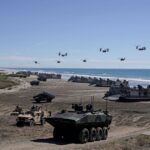
The United States struck back Friday for the attack that killed three service members on Saturday.
“U.S. Central Command (CENTCOM) forces conducted airstrikes in Iraq and Syria against Iran’s Islamic Revolutionary Guards Corps (IRGC) Quds Force and affiliated militia groups,” a news release from U.S. Central Command said.
“U.S. military forces struck more than 85 targets, with numerous aircraft to include long-range bombers flown from [the] United States. The airstrikes employed more than 125 precision munitions,” the release said.
“The facilities that were struck included command and control operations centers, intelligence centers, rockets, missiles, unmanned aerial vehicle storage, and logistics and munition supply chain facilities of militia groups and their IRGC sponsors who facilitated attacks against U.S. and Coalition forces,” the release said.
According to ABC, B-1 bombers based in the U.S. participated in the attacks.
National Security spokesman John Kirby said the attacks were the beginning of the American response, according to NPR.
BREAKING: U.S. begins a wave of airstrikes retaliating for a fatal drone attack, targeting militants in Iraq and Syria, officials say. https://t.co/SbgylVtBpF
— The Associated Press (@AP) February 2, 2024
“It’s very possible you will see a tiered approach here,” Kirby said, “not just a single action, but potentially multiple actions over a period of time.”
Will this lead to a larger conflict in the Middle East?
Yes: 100% (3 Votes)
No: 0% (0 Votes)
The strikes came in retaliation for an attack Saturday on the Tower 22 facility in Jordan that killed three members of the Georgia National Guard.
Defense Secretary Lloyd Austin indicated Thursday at a Pentagon briefing that the goal of the strikes is to reduce the capacity of various groups to attack American troops.
“I don’t think the — the adversaries are of a one and done mindset. And so they have a lot of capability, I have a lot more. And — and so, you know, we — we’re — we’re — as I said earlier, we’re going to do what’s necessary to protect our troops and our interests,” he said.
“I think everyone recognizes the — the — the challenge associated with making sure that we hold the right people accountable, that — that we do everything necessary to protect our troops and that we manage things so that it — they — they don’t escalate. I don’t think there’s any — any set formula for doing this,” he said.
Austin called the Saturday attack “egregious, in that — you know, the attack was on the sleeping area of one of — of our base.”
Prior to the attack, Brian Katulis, a senior fellow at the Middle East Institute, said the critical question in President Joe Biden’s decision on what to attack has been calibrating the response, according to The New York Times.
“The question Biden faces is whether he just wants to react to events in the region or whether he wants to send a bigger message that attempts to restore a sense of deterrence that just hasn’t existed in the region for months now,” he said.
“I’m sure they’re looking for some kind of Goldilocks response here,” he added, meaning “not too hard” that it leads to a wider war, “not too soft” that it changes nothing “but something that seems just right.”
Although some Republicans called for direct attacks on Iran, that’s not likely in the coming days, Suzanne DiMaggio, a senior fellow at the Carnegie Endowment for International Peace, said, according to Bloomberg.
“A direct attack on Iranian territory runs the high risk of igniting an expanded war by design or by accident,” she said.
Thomas Spoehr, a retired Army lieutenant general and national security consultant, said “uniformed Iran service members” would be a likely target, adding, “I don’t think these people are probably hard to find.”






